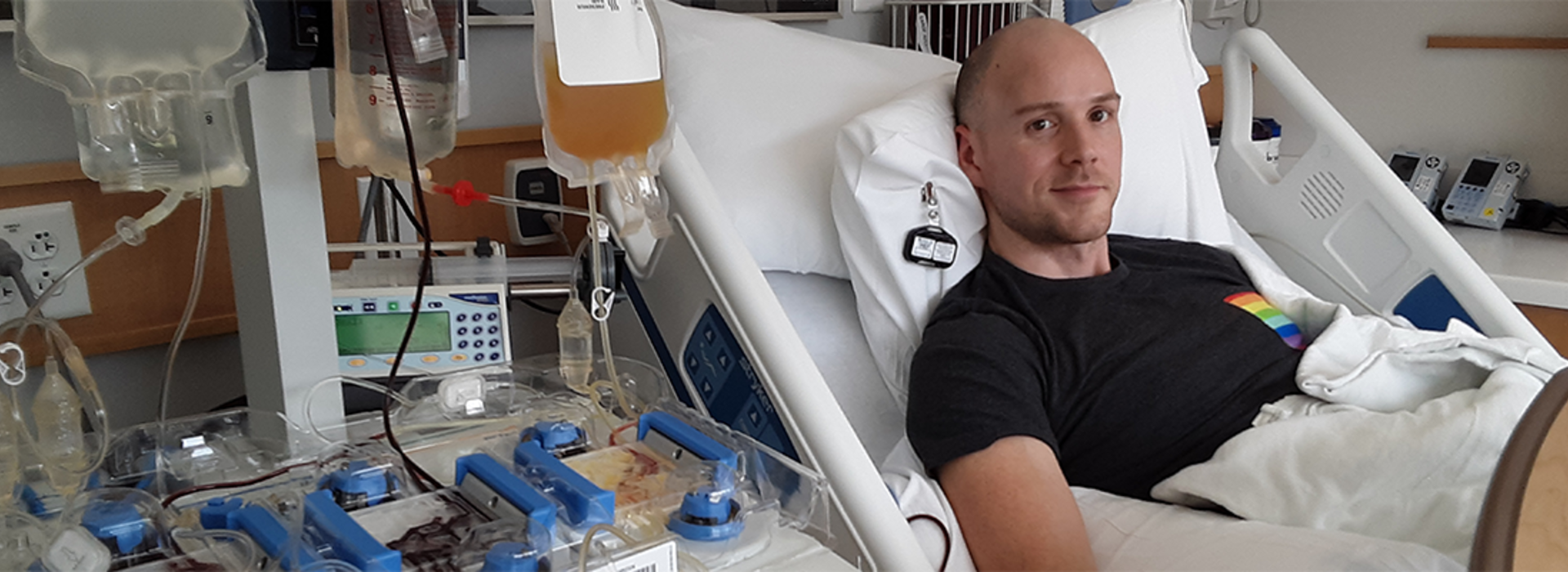
Blood and Marrow Donation "Opportunity of a Lifetime"
The room isn’t much to look at- furnished only with a hospital bed, a single chair, and a small desk with a computer for the nurse to input patient data. But what is happening at this outpatient room at the University of Minnesota Health Clinics and Surgery Center far exceeds appearances.
“A lot of people call this ‘liquid gold,” said Lorna Domingo, ApheresisRN, University of Minnesota Health, gesturing bags of fluid hanging from a machine next to the patient’s, Chris’s, bed.
The whirl of the machine separating the 33-year old’s stem cells from his blood reverberates in the small space. It’s a sound he’s grown accustomed to over the past few hours, and will become even more familiar in the hours ahead. Chris is in the middle of a seven to eight hourPeripheral Blood Stem Cell Donation (PBSC). It is one of two methods of collecting blood-forming cells for bone marrow transplants.
“I have this image in my mind of who the recipient is, what’s going to happen when they get the transplant,” says Chris, looking at the machine hooked up to his arm.
Chris does not know who he is donating to. The decision for him actually began years ago, after a friend of a friend passed away after receiving a bone marrow transplant. In June 2017, Chris finally decided to sign up for the Be The Match Registry. Within 1 year, he was notified that he was a potential match for a patient.
Stem cells are immature cells from the bone marrow that can turn into mature red blood cells, white blood cells, or platelets. Certain medications can be used to increase the number of stem cells in the blood. In a Peripheral Blood Stem Cell Donation (PBSC), stem cells are collected from the blood using a machine that separates the blood using a centrifuge. The stem cells are collected into a bag and the rest of the blood is returned to the patient.
A bone marrow transplant replaces a person's abnormal stem cells with healthy ones from another person and is most often used to treat patients with blood cancers or other blood disorders. This procedure allows the recipient to get new stem cells that work properly. It’s like a system reboot. Many people don’t have a fully matched donor in their family, in fact, 70 percent of patients depend on Be The Match and committed donors like Chris.
“What he is doing is amazing- donating to someone he doesn’t even know,” said Domingo. “He’s an unsung hero.”
As a member of University of Minnesota hospital staff, Domingo sees first hand just what a difference donations like Chris’s make. People travel from around the world for Bone Marrow Transplant (BMT) treatment at University of Minnesota Medical Center and University of Minnesota Masonic Children's Hospitals. Experts have provided clinical care and innovative research through the Medical School for more than 50 years. The institution is celebrating its 50th anniversary of blood and marrow transplantation this year.
Chris doesn’t see himself as a hero. For him, the best way to explain and understand why he is doing this is to simplify it in the way he explains it to his 4 ½-year-old daughter.
Chris asks her if she would do this for a stranger- get poked with needles and go through a little discomfort- every time she says no, not for a stranger. He asks her would you do it for your cousin? She doesn’t hesitate- “Yes!” Then he asks, what about for someone else’s cousin? She pauses, thinks for a moment before answering confidently yes again.
“It’s so easy,” Chris says. “How many times in your life do you have the opportunity to save someone’s life?”